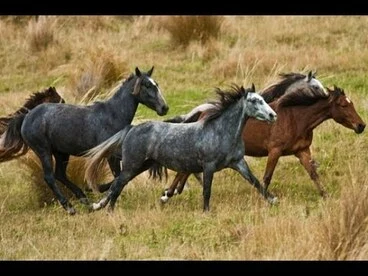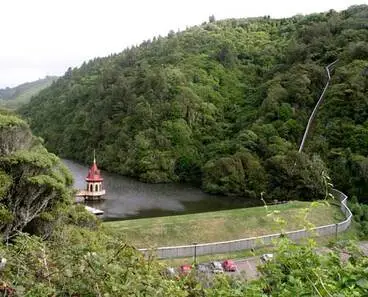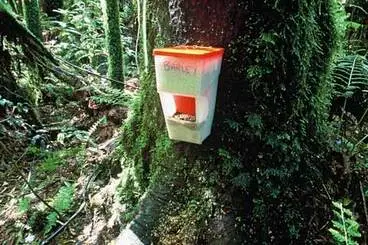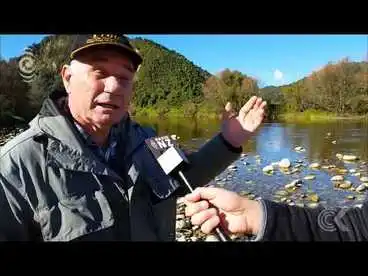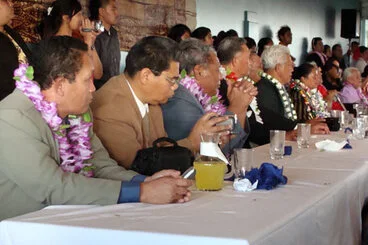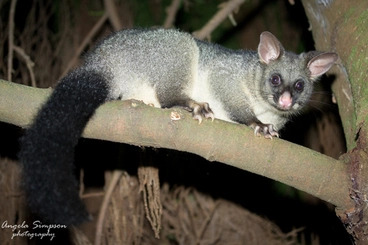Ecological Restoration
A DigitalNZ Story by National Library of New Zealand Topics
Colonial settlers, companies and successive governments undertook widespread destruction of New Zealand’s native forests and swamps. Since then local and national efforts and initiatives have sought to reforest and preserve what is left. SCIS no. 5415855
Kaimanawa wild horse muster
Department of Conservation Te Papa Atawhai
A naturalist attributes deforestation, increased settlements and introduction of animals as some of the reasons for extinction of birds in New Zealand.
NATURE NOTES (Evening Post, 15 January 1927)
National Library of New Zealand
Ecological Restoration
Radio New Zealand
Maungatautari Ecological Island
Manatū Taonga, the Ministry for Culture and Heritage
New Zealand’s protected areas are its 13 national parks and a large number of reserves.
Protected areas: New Zealand’s protected areas
Manatū Taonga, the Ministry for Culture and Heritage
Conservation rankings
Science Learning Hub
Ecology Action Group demonstrators in Wellington
Alexander Turnbull Library
Wetland restoration
Manatū Taonga, the Ministry for Culture and Heritage
Clare St Pierre speaks about the restoration activities like pest control, protection and restoration programmes at Mt Pirongia.
Pirongia Restoration Society
Te Awamutu Online
Arbour Day 1987
Upper Hutt City Library
Native replanting
Manatū Taonga, the Ministry for Culture and Heritage
Regeneration through gorse
Manatū Taonga, the Ministry for Culture and Heritage
Zealandia
Manatū Taonga, the Ministry for Culture and Heritage
Possum bait station
Manatū Taonga, the Ministry for Culture and Heritage
1080 carrots
Manatū Taonga, the Ministry for Culture and Heritage
Plant nursery, Tiritiri Matangi, 1988
Manatū Taonga, the Ministry for Culture and Heritage
Wetland restoration
Manatū Taonga, the Ministry for Culture and Heritage
It's in our nature, Aongatete Restoration Project
Forest and Bird
Te Teko tree planting by the Rangitaiki River in New Zealand
Services to Schools
School takes on a wetland restoration project
Services to Schools
Scenery preservation 1903-1953
Services to Schools
NZ's natural resources
Services to Schools
Conservation – a history
Services to Schools
New Zealand as ecosystems
Services to Schools
Sanctuary Mountain Maungatautari
Services to Schools
Restoration resource centre
Services to Schools
Growing more of the manuka already on your land
Services to Schools
NZ conservation jobs
Services to Schools
New strategy to tackle 'crisis' state of New Zealand's biodiversity
Services to Schools
New Zealand bird sanctuaries
Services to Schools
Scenery Preservation Act
Services to Schools
Northland resurrection
Services to Schools
A vision to restore the environment
Services to Schools
Kaitiakitanga – guardianship and conservation
Services to Schools
Centre for Biodiversity and Restoration Ecology
Services to Schools
QEII open space covenants
Services to Schools
Pest control
Services to Schools
Preserving waterways
Services to Schools
New Zealand's wetlands
Services to Schools
Northland’s forest collapse
Services to Schools
Mangarakau Wetlands
Services to Schools
Restoring the ecology of Maungatautari
Sanctuary Mountain Maungatautari is a North Island ecological wildlife sanctuary. It’s governing body, the Maungatautari Ecological Island Trust, was formed in 2001 by the Maungatautari community, local landowners, local iwi and the government. ‘The maunga’ was a dream project to restore and provide a safe ecological haven for endangered New Zealand birds, bats, reptiles, tuatara and giant weta. Takahē are just one example of the kind of rare birds found there. The Takahē Recovery Programme has been developed at Maungatautari to strengthen the bird’s survival rate. Spread across 3400 hectares of New Zealand forest, the Maungatautari project was judged one of Australasia’s top 25 ecological
Alexander Turnbull Library
Save our wetlands
Wetlands occur where the water table is closest to the surface of the land. This ‘land’ can be permanently or temporarily covered by water. These places such as swamps, mangroves and estuaries, often sustain a rich animal and plant life. However, human activity has been the largest threat to New Zealand’s wetlands. This cartoon refers to a report by the Conservation Minister of the time that New Zealand has lost 90% of its wetland and it is still continuing. Southland has lost 1000 hectares since 2007. While initiatives have been taken, much more needs to be done to repair and replant our wetlands. World Wetlands Day is celebrated on 2 February each year. The intention is to raise global a
Alexander Turnbull Library
Tiritiri Matangi Island
Tiritiri Matangi is an island off the coast of Auckland in the Hauraki Gulf. As a conservation success, it is a model of ecological reforestation and wildlife restoration. A hundred and twenty years of farming stripped this 220-hectare island bare of its native bush. However, from 1984 to 1994, thousands of volunteers planted over 280,000 trees on ‘Tiri’. Today this open sanctuary is home to over fourteen species of threatened or endangered birds such as the takahē and the kōkako. To ensure their safety, all predators such as stoats, cats and rats were eradicated. The island is now looked after by the Department of Conservation and Supporters of Tiritiri Matangi Inc.
Alexander Turnbull Library
Karori reservoir
The Karori reservoir with its Gothic style water outlet control tower in the centre was decommissioned because a 1978 engineer’s report found the dam to be an earthquake risk. The reservoir is now part of Zealandia, a world first and world class ecological sanctuary. Its ambitious goal is to restore 225 hectares to original forest cover in an effort to protect and support endangered wildlife. Pest eradication, strict bio-security and an 8.6 km predator-proof fence now protects vulnerable native species inside the sanctuary including, tīeke, hihi, spotted kiwi and tuatara.
Alexander Turnbull Library
Tamaki Estuary
An estuary is an area where a freshwater river or stream mixes with salty sea water. Estuaries are unique ecosystems with huge ecological value because they are home to plants like mangroves and sea grasses and thousands of birds, animals and fish. Conservation volunteers, along with Tamaki Estuary Environment Forum and Auckland Council, ran a series of sea and land-based events to clean up the Tamaki Estuary. They removed litter, especially plastic, that can have a major negative impact on birds and fish in that area. Part of the restoration programme included re-vegetation by replanting the local bush area to encourage the return of wildlife.
Alexander Turnbull Library
Matakana Island
Matakana Island lies at the entrance of Tauranga’s Harbour in the Bay of Plenty. This 20 km long and 3 km wide island became the centre for dotterel protection in 1992 thanks to an initiative shown by its community. Major threats to the dotterel population such as cats, stoats, rats and possums were trapped and eradicated from the island. Sunbathers, picnickers and fishermen have been warned to keep clear of the camouflaged nesting sites. Local businesses, schoolchildren and the Department of Conservation have played a vital role in removing weeds to improve breeding sites, providing bait stations to trap predators and spotting scopes to keep a watchful eye on breeding pairs of dotterel.
Alexander Turnbull Library
Forest raising
Nine million trees grown last year’ claims this article from 1911. Even though much of the article gives statistics on the cost of reforestation in New Zealand, it is comforting to know that even then people were considering the importance of environmental tree planting. The second part of the article details prison labour employed to replant areas around Hanmer Springs, Whakarewarewa and Waiotapu Valley areas. Today the Afforestation Grant Scheme (AGS) and the One Billion Trees Programme are examples of recent government initiatives to replant new exotic and native forests in New Zealand.
National Library of New Zealand
Scenery preservation
Ironically the Scenery Preservation Act 1903 was passed for touristic reasons, and not for the conservation reasons advocated by Christchurch politician Harry Ell. It was his championing of the Preservation Bill that helped get it through Parliament’s legislative process. The Bill was New Zealand’s first law to protect sites of scenic and historical interest. The government even set aside 100,000 pounds to promote the purpose of this act. Today we also have the Resources Management Act 1991. This Act focuses on sustainable use, management and development of the potential of natural and physical resources. This is a cover of protection for all our natural resources such as air, water, soil,
National Library of New Zealand
Reclaiming our forest heritage
Services to Schools
Ecological restoration
Services to Schools
Mission to clean up spilled West Coast dump rubbish accomplished
Services to Schools
Restoration Project approved for Raukūmara Forest
Services to Schools
River Restoration - from mountains to sea
Services to Schools
Environmental Issues
DigitalNZ
Forest Service poster published in 1985 shows best planting method for reforestation.
Tree-planting instructions
Manatū Taonga, the Ministry for Culture and Heritage
Celebrate Arbor Day
Services to Schools
The ecology of Te Papa Ōtākaro, Avon River precinct.
Services to Schools
Weed biocontrol education resources
Services to Schools
Restoring mahika kai with tuna research
Services to Schools
Resources for teachers
Services to Schools
DOC Sounds of Science
Services to Schools
The nature reserve with a 500-year plan
Services to Schools
Man Spends 30 Years Turning Degraded Land into Massive Forest
Services to Schools
Robins return to Manawatū
Services to Schools
Ecological restoration of offshore islands
Services to Schools
